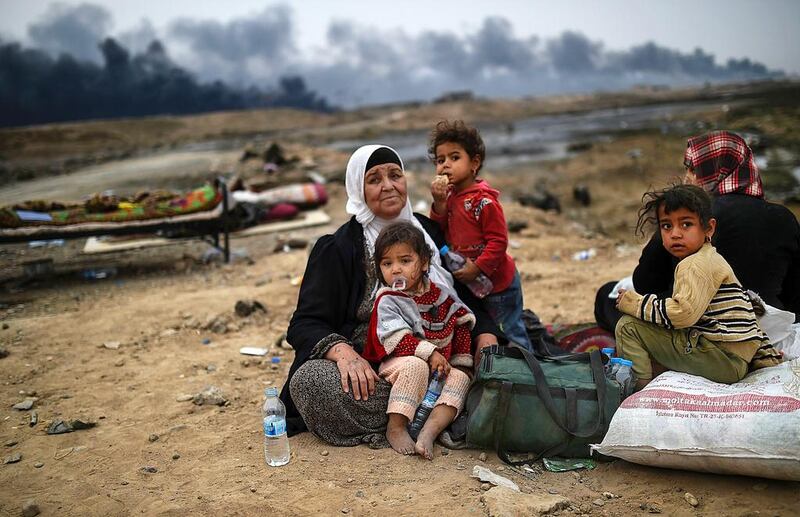BAGHDAD // ISIL has abducted tens of thousands of men, women and children from communities around Mosul and is holding them as human shields inside the city.
The United Nations said the extremists are rooting out anyone they perceive as a potential opponent, focusing on anyone with military training or past links to security forces. At least 232 people were shot dead in and around Mosul on Wednesday. Another 24 were killed the day before.
Civilians from across the region south of Mosul were being herded into Hamam Al Alil, a town under ISIL control where the population has nearly trebled to 60,000 since the forced displacement began. There, the militants separated former members of the security forces from women and children, and took both groups onward to Mosul. They killed 190 former security forces in a military base on the southern edge of the city and killed 42 civilians at another base for refusing to join the extremists.
As well as mass executions, ISIL has bombed civilian targets including markets and mosques and perpetrated a campaign of massacres, enslavement and rape. As Iraqi forces have closed in on Mosul from the north, east and south, growing numbers of civilians have fled ISIL-held areas. The International Organisation for Migration said that as of Thursday, 15,804 people had been displaced since the operation began on October 17.
“This is already worrying because they haven’t yet entered the city,” said Karl Schembri of the Norwegian Refugee Council.
The US military, which is providing air and ground support for the operation, said it tried to disrupt the forced displacement of civilians south of Mosul earlier this week by hitting vehicles being used by ISIL in the forced push. Brigadier General Matthew C Isler of the US air force said the US-led coalition conducted “precision strikes” on vehicles that were unoccupied and far enough away from civilians to avoid harming them.
More than 100 American soldiers are embedded with Iraqi units and hundreds more are based in staging areas.
Brig Gen Isler said Iraqi forces had retaken 40 villages from ISIL near Mosul since the operation began, but most of the fighting has taken place in a belt of sparsely populated farming communities outside the city. The coalition is carrying out three times as many air strikes against the extremists as it did during previous campaigns against ISIL in other Iraqi cities.
Iraqi forces are within five kilometres from the edge of Mosul on the eastern front, where the elite special forces are leading the charge. But progress has been slower in the south, where Iraqi forces are still 35km from the city.
Iraqi forces are halting their advance in order to consolidate gains before moving forward.
“They are pausing and repositioning, refitting and doing some back clearing,” said coalition spokesman Col John Dorrian. “We think it will just be a couple of days and then we are back on the march toward Mosul.”
But ISIL is also suffering heavy losses. “Just in the operations over the last week and a half associated with Mosul, we estimate they’ve probably killed about 800 to 900 ISIL fighters,” said Gen Joseph Vogel, head of US military operations in the Middle East.
Washington estimates there are between 3,500 and 5,000 ISIL fighters in Mosul and as many as 2,000 more in the wider area. While they are still able to travel in small groups, they cannot move in large onvoys, hampering their ability to replace lost personnel. There is evidence of ISIL fighters trying to sneak out of Mosul after dumping their weapons and changing into civilian clothes.
ISIL still controls a corridor of territory west of Mosul linking it with the Syrian part of the caliphate it declared in 2014. But the pressure is on there too with the prospect of a forthcoming offensive on Raqqa, ISIL’s stronghold in Syria.
* Associated Press and Agence France-Presse





